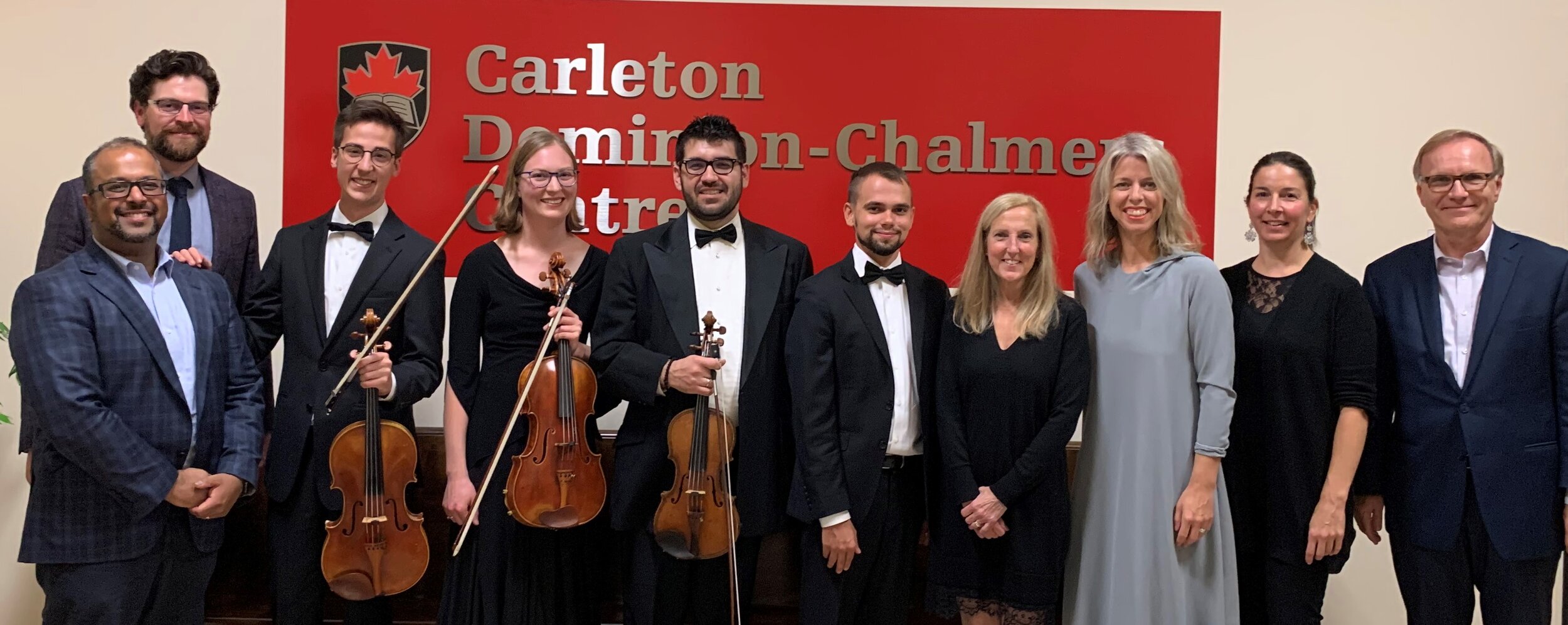Paul Lepsoe Innitiative
Gathered at our Ottawa Symphony October 7, 2019 concert, Lost Love, was some of the "team" bringing the Lepsoe Music Initiative to fruition:
(from L to R) - Dr. Jerry Maniate, VP Education, The Ottawa Hospital; Dr. Dennis Garvin, Director, Cancer Treatment Centre, The Ottawa Hospital; Ottawa Symphony Musicians Tim Coté (viola); Caren Abramoff (viola); George Stathopoulos (violin); Ludovik Lesage-Hinse (clarinet); Dr. Jane Prud'homme, spouse of Paul Lepsoe; Corianne Bell OSO Lepsoe Strings pilot project manager; Cresta DeGraaffe, Ottawa Symphony artistic operations coordinator; and Robert W. Peck, president, Ottawa Symphony.
Cancer is a diagnosis that will impact half of Canadians at some point in their lives. In fact, you probably have some first-hand experience with cancer. And if you do, you know that diagnosis results in significant physical and emotional issues, not least of which is dealing with uncertainty, starting before diagnosis through the rest of the illness journey, and for some, through the end-of-life phase.
What many of us know intuitively about the value of music is enjoying increasing importance in scientific literature. The positive effect of music is being documented on several important health outcomes, including reductions in anxiety, depression, pain, and fatigue in adult cancer patients. But there is sparse literature on the effect of music on cancer patients’ hospital experience, or the effect of music on hospital staff. This is where our story begins.
Paul Lepsoe was a lifelong student of the piano and a lover of classical music. He was also a patient at the Ottawa Hospital where he received treatment for, and courageously fought brain cancer. While friends who visited him in hospital knew he was getting the best of care, they felt that the environment was unnecessarily sterile. A small group decided to fund a pilot, and we called it The Paul Lepsoe Music Initiative. In October-November of 2019, this initiative saw the Ottawa Symphony Orchestra (OSO) and the Ottawa Hospital (TOH) working in partnership to bring music to the TOH Cancer Centre at the General Campus. But with this initiative, we chose to do more than entertain, we took this opportunity to contribute to the growing knowledge on this subject, and to create a recipe for change.
What we did
The initial phase of the project has sought to explore the effect of music on patient and staff experience at TOH Cancer Centre within both public waiting room and chemotherapy treatment room settings, using curated, live musical performance. A joint Ottawa Hospital – Ottawa Symphony project team was convened to determine the framework and evaluation of the initiative. A written questionnaire was developed to gain a better understanding of the difference live music made to patient, family and staff experience for those present during performance times. The results will inform the use of music as a low-cost intervention to support individuals as they experience treatment and care within a hospital setting. When analyzed in the context of the instruments and musical programming, the questionnaires were also seen as a tool in developing our “recipe” for prescribed musical interventions.
Over four consecutive Wednesdays in the fall of 2019, three musicians of the Ottawa Symphony alternated playing 35-minute sets simultaneously, in two designated areas of the Cancer Centre. Musicians were unamplified and consisted of the following instrument groupings: clarinet soloist, violin soloist, violin duo, and viola duo. While musicians played, volunteers and/or staff circulated with the questionnaires. Responses were reviewed after each session in order to integrate feedback into subsequent interventions. What we heard informed how we adjusted the volume, style or repertoire of the music to respond to the needs of the listeners the following week.
What we learned
Overall, more than 85% of respondents told us that they enjoyed the live music. Many commented further on how the music helped shift attention or alter the environment:
“(It) gave us something to talk about other than cancer.” (Family Member)
“It provided a lovely sound in a sterile environment. Was very relaxing and comforting to listen during my wait.” (Patient)
“It's lovely and relaxing. I feel lucky to work here.” (TOH Staff/Physician)
“It completely transformed the waiting experience and mood. I was here in the waiting room at the same time yesterday without music, and I can objectively say that it made a very positive improvement.” (Family Member)
In answer to whether the live music positively affected their hospital experience, approximately 75% reportedly “Agreed” or “Strongly Agreed” that they felt better because of the music.
Considering that each week the musician groupings alternated and the programming was fine-tuned, it is of interest to note that in the final week of the initiative only one out of 55 respondents (1.8%) disagreed with the statement “I felt better because of the music.”
“Key” Notes for Music in Hospital Spaces
A significant majority of respondents (85%) told us that they believe music should be part of the care experience at the Ottawa Hospital.
Hundreds of people at TOH—including patients, family members, staff and volunteers—were reached through this initiative, which cost approximately $640 per session (costs include musician performance and rehearsal fees, and project management), suggesting that music performance can be an effective, low-cost intervention to positively affect the hospital experience across multiple stakeholder groups.
Through this initiative, we were able to observe that in general, patients and staff responded most positively to mellower sounding instruments in this setting.
A “prescribed” approach to musical selections was fine-tuned through this initiative and is a key component to the future success of musical interventions in this context. The high rate of positive responses (and only one negative response) in the final week, can be seen - in large part - as a testament to the sensitivity of the musicians in patient-centered awareness while playing, and as a result of increased precision in artistic direction, thanks to information gleaned from survey responses.
For example, although musicians initially performed repertoire one might commonly find on many classical “relaxation” playlists, in this space we found that slow and tranquil can be translated to “somber” and “morbid.” Further, classical, fiddle- or folk-music – if it portrayed a sense of nostalgia – could be heard as too “melancholy.”
We can conclude that the most pleasing music to the widest audience in this space could be described as: light; optimistic; uplifting; spacious; simple; soothing; not overtly religious or nostalgic; and consistent in texture, dynamics and tempo, i.e. not a lot of contrast. Tempo-wise, it is a fine balance of maintaining an even pace that is not so quick as to over-stimulate or increase heart rates, and - if a slower tempo – ensuring the music maintains a light, uplifting nature.
Most importantly, a high caliber of musicianship is integral; the confident assurity and mastery of the instrument allows the listener to relax into the experience.
Who gave us feedback?
The 200+ responses gathered during this four-week initiative , capture a representative sample of The Ottawa Hospital stakeholders (including their demographics) :
37% were Patients; 32% Family & Caregivers; 19% TOH Staff, Residents/Students & Volunteers, and; 11% did not specify.
Next Steps
Phase 2 of the initiative will consist of individualised, in-patient interventions with a Music Therapist. A limited number of sessions will take place with palliative care in-patients in early 2020.
Based on the information gleaned from this pilot, the Ottawa Symphony will be investigating funding to support bringing music into our city’s hospital and evaluating the on-going feasibility of uplifting members of our community with live curated music, when they are most in need.
Want to know more? Contact us.

